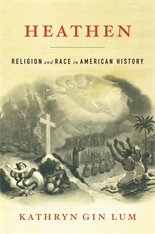The Book
Heathen: Religion and Race in American History
The Author(s)
Kathryn Gin Lum

Adding to the growing historiography on the intersection of religion and race in U.S. history is Kathryn Gin Lum’s brilliant Heathen: Religion and Race in American History. By focusing on the use and abuse of the category of “heathen” in a long scope of American religious history, her book demonstrates the close relationship of religion and race in the past, as well as part of the roots of contemporary White Christian nationalism.
Early in the Introduction, Gin Lum offers a rich description of the book’s main goals: “the notion of the heathen as an elastic category that could stretch to incorporate people from all over the world; the significance of the heathen world to Americans’ self-identification as lucky inhabitants of the ‘First World;’ the responsibility this self-identification was supposed to entail toward the suffering heathen; and the attendant racialization of the heathen as a non-White inferior and the Christian as White superior” (9). This is a rich combination of arguments that overlap and clearly show how categories of race and religion have shaped much of American life.
Following the Introduction are 10 chapters, organized into three sections, and then an Epilogue and Postscript. The book blends an organization that is both chronological and thematic—something incredibly difficult for such wide-sweeping books, but something Gin Lum accomplishes with style and poise. The first section, “Imagining the Heathen World,” explores how the idea of the “heathen world” was built on racist colonialism and White Christian conflating of all “heathens” together, as supposed evidence of their own superiority. This is followed by a three-chapter section called “The Body Politic” that demonstrates how the presence of “heathens” justified the American racism and the claimed superiority of American Protestant whiteness. “Inheritances,” the third section, shows how even if White Protestants don’t use the term “heathen” as much in recent years, the ideas and assumptions behind it remain. The Epilogue ties the book’s threads together again, and the Postscript dives into how assumptions of the U.S.’s civilized status shaped commentary on Covid-19.
The book is rich with stories and examples that persuasively prove Gin Lum’s central arguments. She is attentive to primary sources both from those racist and bigoted authors who railed against those described as “heathen,” as well as those supposedly “heathen” or formerly “heathen” authors who detailed their own experiences, cultural traditions, and practices. The possibility of bringing former “heathens” into the Christianized, “civilized” world also suggested that White Protestants could backslide—a dynamic that both raised questions and anxieties. The result of these complexities is a vivid depiction of a contentious conversation with vast implications on human rights, global politics, and colonialism. In unpacking how they depicted and described the so-called “heathen,” White Protestant Christian Americans revealed much about themselves, their values, their world, and their assumptions. Gin Lum shows how White Protestant Americans both categorized the “heathen” and how that process in turn created their own identity in supposed and bigoted juxtaposition.
Heathen considers the critiques leveled in turn by those supposed “heathens” against White Protestants. Those oppressed noticed how the purportedly “civilized” Protestants seemed to worship money and power and often did not follow the morals of their own tradition. Her analysis here is reminiscent of historian of religion Charles Long’s landmark work on the cargo cult phenomenon and his insights of how scholarly critiques of that allegedly “primitive” religious practice revealed much more about the “modern man” who studied them.[1] Gin Lum provides expert and critical analysis of what concerns about and assumptions about so-called “heathens” elucidates about those constructing them as religio-racial others.
Considering that this is a society about intellectual history, I find it necessary to laud the book’s ability to consider the importance of ideas as well as materiality. While not an advertised book about material religion, Gin Lum’s attention to how White Protestants thought about “heathen” bodies and landscapes illustrate the importance of considering the material world in our studies of ideas.
One element of the book that I particularly appreciated was the Prologue, in which Gin Lum wrote of the book’s relationship to her family and personal history, as well as protests over the death of George Floyd, the Covid-19 pandemic, and its resulting rise in anti-Asian sentiment in the nation. While personal discussions in books can be off-putting or heavy-handed, her inclusion of contemporary issues, her childhood experiences with the missionary impulse and degradation of the “heathen,” and her own current faith added important context to the book. Academic work is often personal in many ways, even as authors try to obscure it. This Prologue made a strong case for the importance of recognizing that academic work is never divorced from the scholar’s world life and further proved the importance of the book’s significant contribution.
In short, this is a book that will be of interest to scholars and students of American religious history, the history of race in America, critical race studies, and more. Gin Lum’s writing style is nuanced, clear, detailed yet expansive, and accessible, which will make the book a fit for both graduate and undergraduate classrooms. Any scholar of American history should have a copy.
[1] Charles H. Long, “Cargo Cults as Cultural Historical Phenomena,” Journal of the American Academy of Religion 42.3 (Sept 1974): 403–414.
About the Reviewer
Brief Reviewer Bio: Emily Suzanne Clark is an associate professor of Religious Studies at Gonzaga University. She is the author of the award-winning book, A Luminous Brotherhood: Afro-Creole Spiritualism in Nineteenth-Century New Orleans (University of North Carolina Press, 2016) and co-editor of Race and New Religious Movements in the USA: A Documentary Reader (Bloomsbury Press, 2019) and Digital Humanities and Material Religion: An Introduction (De Gruyter, 2022). Her current book project explores the materiality of American Spiritualism. You can find her online here: https://esclark.hcommons.org

0